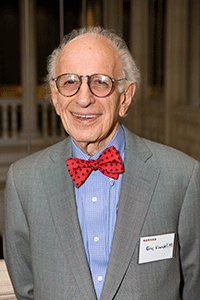A Nobel Laureate on ‘Successful Aging’ - Dr. Eric Kandel’s Epic Search for the Biological Basis of Memory
A Nobel Laureate on ‘Successful Aging’ - Dr. Eric Kandel’s Epic Search for the Biological Basis of Memory

From The Quarterly, Winter 2012
Imagine that you are standing on a busy city street corner and you gather together the first 100 passersby who are precisely 70 years old. “In this randomly selected group, let’s assume that men and women are equally represented and that none of them appears to be suffering from any major illnesses, including any kind of cognitive impairment.”
The speaker is Dr. Eric Kandel, NARSAD Distinguished Investigator Grantee and member of the Brain & Behavior Research Foundation Scientific Council, whose seminal discoveries about the biological basis of memory earned him a Nobel Prize in 2000.
“If we were to measure these one hundred 70-year-olds with very sensitive indices of cognitive function, we’d discover that 40 of them have memory comparable to what they had when they were in their forties.” This, says Dr. Kandel, “is what we call ‘successful aging.’”
And the remaining 60? Extremely sensitive tests would reveal that these individuals were destined to have one or another form of cognitive impairment.
“It‘s roughly half and half in this group of 60,” explains Dr. Kandel. “About 30 will have a mild, age-related type of memory decline, which usually takes the form of forgetting the names of people or where one has placed the house keys—information that does come back and can be remembered, just not immediately. This kind of age-related memory loss is relatively benign, even though it’s a source of frustration and does tend to progress, to varying degrees.”
We have accounted, then, for 70 people in the randomly selected group: 40 are in good shape and 30 have begun a gradual and moderate decline that typically affects short-term memory. The remaining 30 people, on average, will go on to develop Alzheimer’s disease, “which is a truly devastating, progressive illness that involves severe memory loss, impairments in language, motor coordination, and other brain functions.” Dr. Kandel clarifies that among this unlucky 30 percent, the biological processes that lead to Alzheimer’s will typically have begun by age 70 although symptoms may not appear for years.
Dr. Kandel—who is familiar to many non-scientists as Charlie Rose’s co-host in Mr. Rose’s ‘The Brain Series’ on PBS—and members of the Kandel laboratory group at Columbia University perform research that has uncovered some of the key molecular and genetic processes that give rise to memory as well as to the loss of memory. The intellectual roots of this work can be traced back half a century, to a time when Dr. Kandel made the fateful, and for us, fortunate decision to shift his focus from psychiatry to neuroscience.
As told in his award-winning autobiography, In Search of Memory (2006), his growing interest in the biological basis of memory mirrors (and in some ways foreshadows) the progress of an entire field. Or, more exactly, the converging of two fields that traditionally had stood apart from one another. “If you step back a bit, to the 1950s, you realize that what really distinguished psychiatry from neuroscience was its overwhelmingly clinical focus. At that time, relatively little work had been done on the basic biology of psychiatric disorders.”
For a variety of fascinating reasons explained in novelistic detail in his book, Dr. Kandel in the early 1960s became determined to use rapidly evolving technologies to trace and record neural impulses, and thereby to determine the precise mechanisms of individual neural circuits.
As he turned his experimentation to the mechanisms of memory formation, he decided to use as his model the large marine snail called Aplysia californica, hoping not only to show that this comparatively simple animal could learn to avoid unpleasant stimuli, but also to show at the level of cells and circuits how it learned. He wanted, in other words, to understand how experience-related memories were formed and retained for later recall.
Now famous in the annals of science, these experiments sent Dr. Kandel’s career on a magnificent trajectory. He points out that beginning in the 1980s, his NARSAD Grant played a vital role in extending and vastly broadening the type of research that his team pioneered —generating experimental evidence to explain for the first time in biological terms how and why our minds work as they do.
“The Brain & Behavior Research Foundation, through its NARSAD Grants, has made an extraordinary contribution, not only in providing funds for psychiatric research but in helping to structure the field,” he says. “Because of Connie and Steve Lieber’s vision and Dr. Herb Pardes’ energy and knowledge, the Foundation was able to build a platform for recruiting new people as well as supporting accomplished people already in the field. This has made an enormous impact in our collective attempt to discover the biological basis of psychiatric disorders.”
One of Dr. Kandel’s great contributions has been to show convincingly that we can model important aspects of the human brain’s function in animals. “We found that creatures like the snail or the mouse use the same molecules to organize their maneuvering through their environment that we use to govern our daily lives and adjust to our own environment,” he has written.
Just in the last year, his team at Columbia has succeeded in creating a new line of mice that model the problems of motivation seen in people with schizophrenia. “Motivation has two components, ‘wanting’ and ‘liking,’” Dr. Kandel explains. “If you ask a person with schizophrenia to come to your house for dinner, he will typically refuse, saying it’s too much trouble. They don’t want to put out the effort. But if you drag them to your house and serve a nice dinner, you notice that they enjoy it as much as you and I. They enjoy the experience, but don’t tend to seek it out.
“We found to our amazement that you can test for wanting and liking in the mouse. In our mouse that models this aspect of schizophrenia, they ‘like’ things as much as healthy mice; but they have a terrific deficit in ‘wanting.’ When I presented this data recently at Johns Hopkins, a man in the audience later came over to me and said, ‘My son is just like your mouse!’ It was an extraordinary moment!”
At 82, Dr. Kandel has lost nothing of his mental acuity, none of his intellectual curiosity, and not a bit of his sense of humor (his signature guffaw still can set an entire room into peals of laughter). Scientific discoveries provide him with the same intoxicating rush of excitement and satisfaction that they did years ago. And this raises an important point about aging and memory loss.
“There is a consensus that you can do certain things to prevent non-Alzheimer’s age-related memory loss,” he points out. “It’s agreed that good health is important. Staying physically fit, seeing your physicians, following their advice. Getting your blood pressure under control—and if you have diabetes, getting it under control. Getting your lipid levels under control. Staying physically active by doing exercise, staying socially engaged; staying intellectually engaged.”
In other words: “you lose it if you don’t use it”? That does indeed appear to be true, Dr. Kandel says, specifying that mental exercises involving doing things you have not previously done—say, for instance, memorizing poetry—can really help as you enter old age. This can act as a prophylactic for non-Alzheimer’s age-related memory loss, he says. As for Alzheimer’s, it is not at all certain that any of these things will help.
Plaque-like accumulations of proteins—beta-amyloid proteins, specifically—have long been associated with the occurrence of Alzheimer’s and have been found to be prevalent in the brains of those who have died with the illness. Recent attempts to develop drugs to break up these sheet-like plaques in humans have failed, however. Animal models are a step forward. “You can take a mutated gene that gives rise to these plaques, place it in a mouse, and they will develop early-stage Alzheimer’s,” says Dr. Kandel. But the illness in humans takes about 10 years to develop once plaques begin to appear. That progression hasn’t yet been modeled successfully in mice.
He speculates that the drugs used so far in human trials may have failed because they have been given too late—years after the plaques have begun to accumulate. On the other hand, an approach other than attacking the plaques may be what is needed. It is still too early to know. In contrast, experimental drugs to boost memory in non-Alzheimer’s age-related memory loss have shown a good deal of progress in the clinic.
With continued research, Dr. Kandel is confident the answers will be found and the right treatments developed. Our most complex organ can lead us, with enough of the right explorations, to unraveling its own mysteries of function—and dysfunction.



